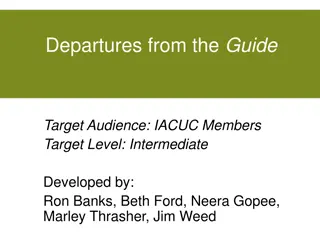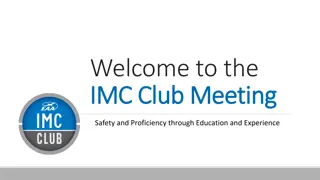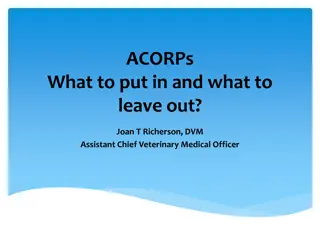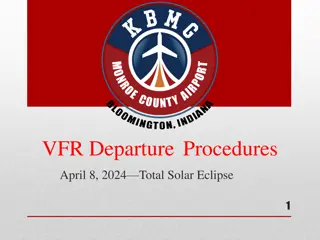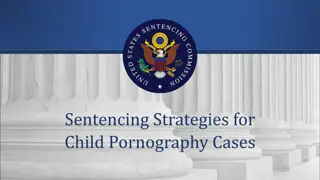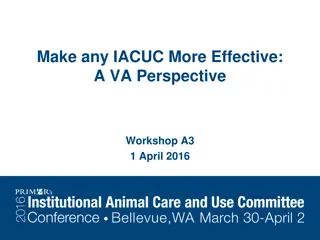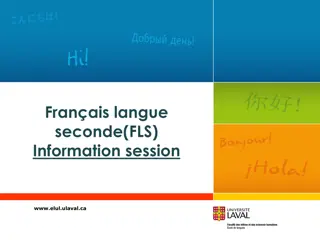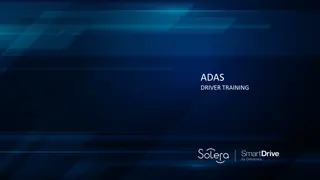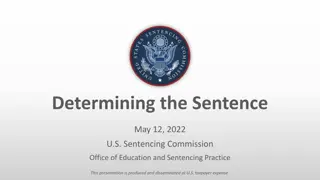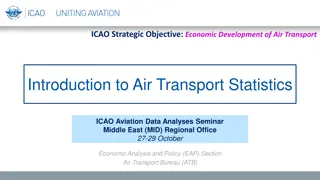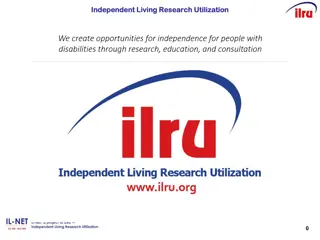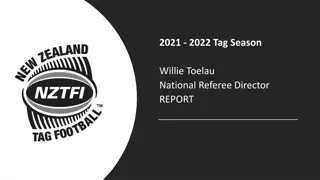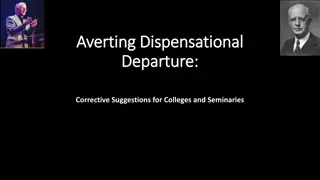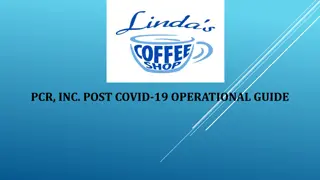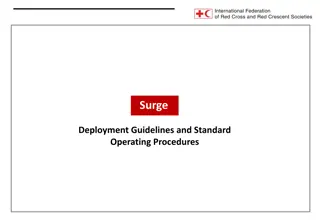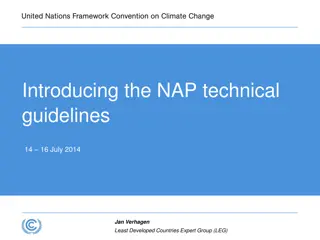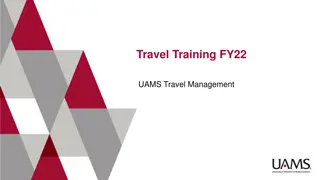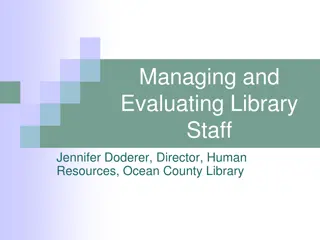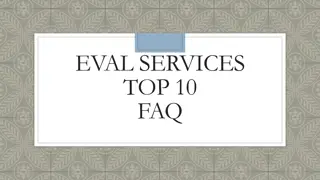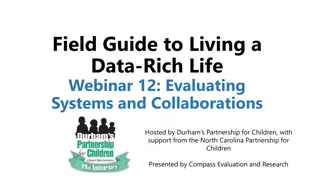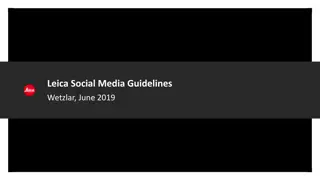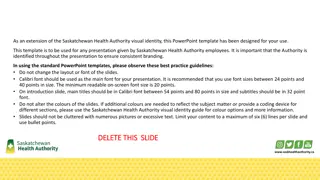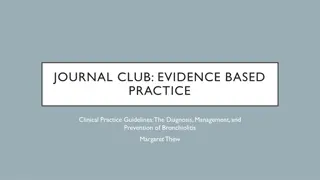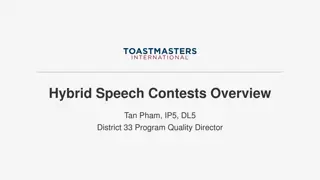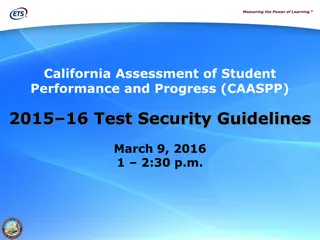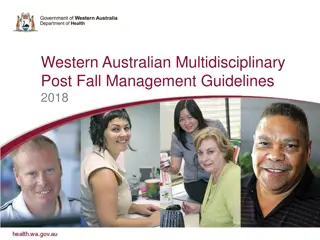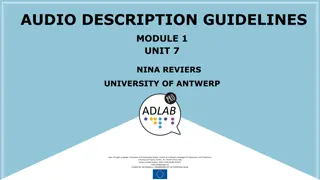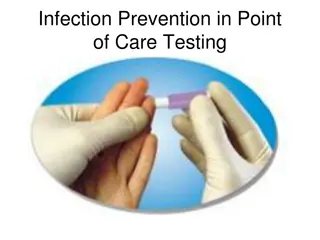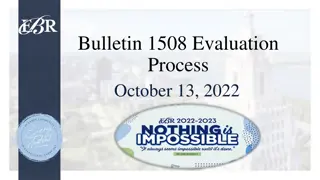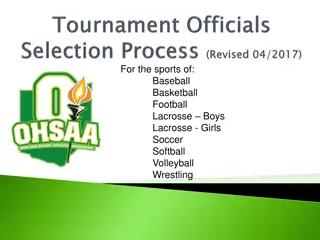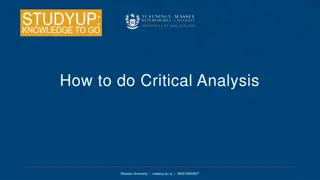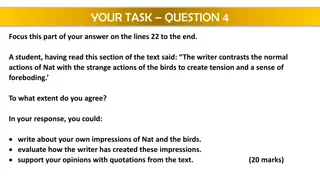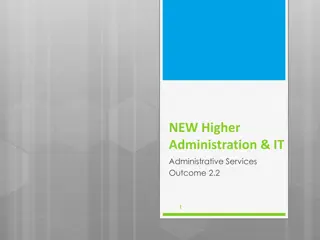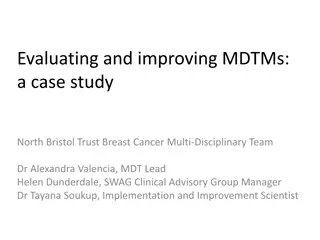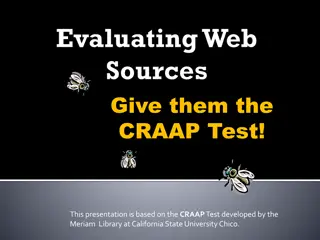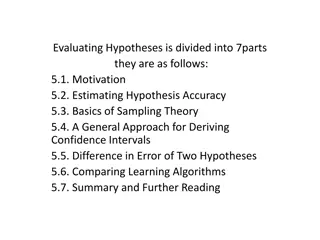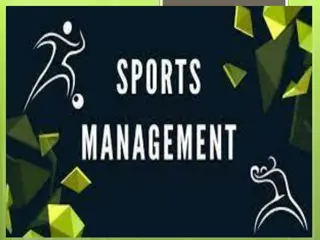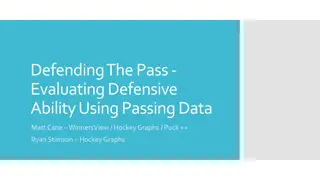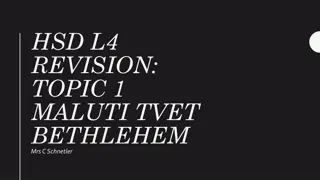Guidelines for Evaluating Departures from the Guide
Understand the definitions of standards, deviations, and departures in animal research protocols. Learn to differentiate between perceived and true departures, evaluate their impacts, and identify reporting requirements. Experienced IACUC members and administrators can develop essential skills to ensure animal welfare and scientific practices while evaluating departures from regulatory guidelines.
Download Presentation

Please find below an Image/Link to download the presentation.
The content on the website is provided AS IS for your information and personal use only. It may not be sold, licensed, or shared on other websites without obtaining consent from the author. Download presentation by click this link. If you encounter any issues during the download, it is possible that the publisher has removed the file from their server.
E N D
Presentation Transcript
Departures from the Guide Elizabeth Dodemaide, Rutgers University Jo Ann Henry, NYU School of Medicine Alison D. Pohl, UConn Health Claudia Swanson, Yale University Sandra Wilkins, Michigan State University
DEFINITIONS Standards = all regulations, policies, and guidelines Deviation = things different from the norm Departures = deviation from the standards of the Guide that have to be reported Perceived departures= what you start with when reading protocols or found on a semi-annual inspection; may be departures - not sure, need more information True departure = assessed and confirmed Must = minimum standard required of all assured institutions Should = often involve performance standards May = suggestion that an institution can use if they choose to do so
DEFINITIONS Links for further definitions: OLAW webpage on departures from the Guide: https://grants.nih.gov/grants/olaw/departures.htm
AUDIENCE Experienced IACUC members Experienced IACUC administrators Audience members should have a copy of the Guide
GOAL To have the audience develop a skill set to evaluate departures from the Guide in conjunction with animal welfare and sound scientific practices
OBJECTIVES Recognize the relevant resources Identify perceived departures from the Guide Differentiate between perceived and true departures Evaluate potential impacts from the departure Identify reporting requirements and process
RESOURCES It is essential that IACUC members recognize resources that can be used to determine if something in a protocol or found on a semi-annual inspection might be a deviation from the Guide It is also essential for IACUC members to recognize resources that will help determine if a deviation is reportable to any federal agency
RESOURCES BRAINSTORM What are the relevant resources that are used to determine departures from regulatory mandates (for this presentation - the Guide)?
RESOURCES Guides (8thEdition, Ag guide, Field guides ) AWA, AWR, AWS, ACP PHS Policy AVMA Euthanasia Guidelines PHS Assurance AAALAC Program Description Subject matter experts
DEPARTURES As IACUC members, you need to recognize potential departures when reviewing protocols or the animal care and use program e.g. when inspecting animal facilities and labs It is important to realize that something may or may not be a departure from the Guide
POTENTIAL DEPARTURE? Single Housing What if this is an adult breeding male? What if this is 1 of 4 littermates all of the same sex? What if it is the last experimental mouse in the cage?
THINK-PAIR-SHARE To do this exercise, get out your copy of the Guide In your group, identify 5 potential departures from standards (2 minutes)
THINK-PAIR-SHARE Each group is assigned 1 departure (3 minutes) Develop a scenario in which your departure would be: Perceived departure True departure Not a departure
SINGLE HOUSING EXAMPLE So, let s look at our initial example of single housing because if you see single housing in a protocol, it should pique your interest But is it a departure? Is it a social species? Is it a fighting male that is going to be separated? Is it a post-surgical animal where aggression is anticipated and needs to be avoided? Does it have an exception in the Guide? You can see that we almost always need more information to be sure
SCENARIOS AND POLLING SCENARIO ONE An institution has housed all dogs in small social groups One of the dogs is older and the AV determines that social housing isn t appropriate because of arthritis and requires specialized care (e.g., softer flooring) The IACUC is notified of the requirement for single housing
SCENARIO ONE POLLING QUESTIONS Is this a Deviation from the Guide: A Yes B No Does this need to be reported in the semi-annual report? A Yes B - No
SCENARIO ONE ANSWERS The Guide states that social animals should be housed socially unless they need to be single housed for experimental reasons or incompatibility. Single housing should be an exception based on experimental requirements or veterinary concerns about an animal s well-being. In this scenario, this is a deviation from a should statement but it is acceptable according to the Guide because of the veterinarian s concern, so it is not a departure from the Guide. It does not need to be reported in the semi-annual report.
SCENARIOS AND POLLING SCENARIO TWO The IACUC is holding its semi-annual review and realizes that one department s laboratories were not reviewed during the last semi-annual inspection. The IACUC Administrator informs the IACUC that the laboratories were last inspected 11 months ago.
SCENARIO TWO POLLING QUESTIONS Is this a deviation from the Guide? A Yes B - No Does this need to be reported in the semi-annual report? A Yes B - No Does this need to be reported to a federal agency? A Yes B - No
SCENARIO TWO ANSWERS The Guide states that both the HREA and AWA require the IACUC to inspect animal care and use facilities, including sites used for animal surgeries, every 6 months. As OLAW expects areas in which animals are used for surgical procedures to be inspected every 6 months, this would be non- compliance with PHS Policy This must be reported to OLAW, and the IACUC would have to develop a plan of action and a schedule to correct this deviation.
DEPARTURE SUMMARIES Specifically Described Exceptions If an activity is performed according to a specifically described exception listed in the Guide, then: It is not a departure It does not need to be listed in the semi-annual report It does not need to be reported to OLAW
DEPARTURE SUMMARIES Deviating from a Must If you are deviating from a must statement in the Guide based on IACUC- approved scientific, veterinary, or animal welfare reason, then: It is an approved departure It must be detailed in the semi-annual report It does not have to be reported to OLAW If you are deviating from a must statement in the Guide and there is no IACUC approval, then: It is not only a departure, it is non-compliance It must be reported to the IO It must be reported to OLAW
DEPARTURE SUMMARIES Deviating from a Should If you are deviating from a should statement that is based on an established performance standard, then: It is not a departure from the Guide It does not have to be reported in the semi-annual report It does not have to be reported to OLAW If you are deviating from a should statement that is based on an IACUC-approved scientific, veterinary, or welfare reasons, then: It is an approved depature from the Guide It is reported in the semi-annual report It does not have to be reported to OLAW If you are deviating from a should statement without IACUC approval, then: It is not only a departure, it is non-compliance It needs to be reported to the IO It needs to be reported to OLAW
CONCEPT MAPPING Create a concept map illustrating potential impacts from your assigned departure (5 minutes)
SUMMATIVE ASSESSMENT You are reviewing a protocol submission in which the Investigator proposes to singly house cotton rats. The Investigator will bring the animals to his/her laboratory to perform a surgery for implantation of a cannula. The cannula will be used to administer a non-pharmaceutical grade experimental compound and the animals will be housed overnight in the laboratory. Cotton rats will be euthanized by lethal injection.
SCENARIO QUESTIONS 1. Identify the perceived departures in this scenario. 2. List the relevant resources to evaluate the perceived departures. 3. What further information is needed to determine if the perceived departures are true? 4. As written, do any potential departures require reporting and, if so, to whom and why?
SUMMARY Following this module you should now be able to: Recognize the relevant resources Identify perceived departures from the standards Differentiate between perceived and true departures Evaluate potential impacts from the departure Identify reporting requirements and process
Acknowledgements Special thanks to Dr. Patricia A. Brown, Director, OLAW. Her OLAW online seminar (9/13/12, revised 10/4/12) was instrumental for this training.


